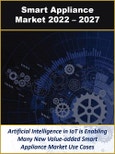Artificial Intelligence in IoT is enabling Many New Value-added Smart Appliance Market Use Cases
Speak directly to the analyst to clarify any post sales queries you may have.
This report evaluates the smart appliance marketplace including technologies, companies, solutions, products, and services. The report includes an analysis of leading companies and their strategies and offerings.
The report evaluates the use of converged AI and IoT systems/solutions known as AIoT to enable intuitive and value-added human-to-machine smart appliance interactions. The report also provides market projections with forecasts covering the period 2022 to 2027 for all major aspects of the smart appliance market including technologies, solutions, applications, and services.
Select Report Findings
- AIoT in home automation market will reach $10.2B globally by 2027
- Smart appliances are evolving to embrace the “as a service” product model
- Combined AI and IoT solutions will drive significant smart appliance market value
- Leading smart appliance vendors are focusing on cloud-based services and improved user interfaces
- The DIY segment for smart home/appliance integration is expected to exceed 47.5% of the total market by 2027
Related to Connected Home technologies, smart appliances leverage the Internet of Things (IoT) and are connected to the Cloud and control infrastructure such as utilities/smart grid to enable more efficient and more productive use of electricity. Smart appliances include thermostats, clothes washers, dryers, microwaves, hot water heaters, and refrigerators. Smart appliances rely upon various communications technologies including Wi-Fi, ZigBee, Z-Wave, Bluetooth, and NFC, as well as IoT and related operating systems for consumer command and control such as iOS, Android, Azure, Tizen.
Implementation and operation are becoming increasingly easy for end-users, facilitating rapid growth in the Do-it-Yourself (DIY) segment. Smart grid integrators play an important role defining smart appliance standards through transferring knowledge, testing efficiency, and optimizing systems and networks that would communicate with both utilities and smart appliances. These companies and other entities ensure intelligent appliances receive real-time data from the AMI system to control or modulate their operation.
One of the important areas to consider within the smart appliances market is the convergence of AI and IoT, which is also known as the Artificial Intelligence of Things or AIoT. Currently, many AIoT use cases are very retail product-oriented, many of which focus on cognitive computing in consumer appliances. Sharp refers to AIoT as “People-Oriented IoT = AIoT” for “more responsive technology” as part of what they refer to as the “Smart Life”. They provide examples of smart homes in which the system learns how its occupants like to live through interaction with smart appliances and housing equipment.
With the purchase of this report at the Multi-user License or greater level, you will have access to one hour with an expert analyst who will help you link key findings in the report to the business issues you're addressing. This will need to be used within three months of purchase.
This report also includes a complimentary Excel file with data from the report for purchasers at the Site License or greater level.
Table of Contents
1. Executive Summary
Companies Mentioned
- Bosch Hausgeräte GmbH
- Electrolux
- General Electric
- Haier
- Indesit
- LG Electronics
- Miele
- Panasonic Corporation
- Philips
- Samsung Electronics
- Whirlpool Corporation
Methodology

LOADING...








